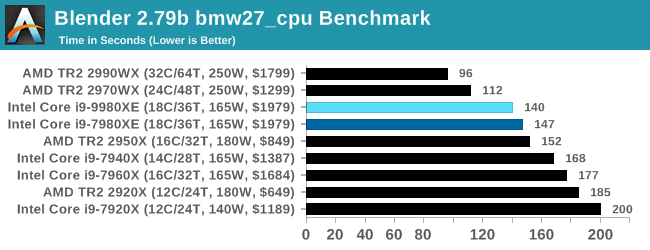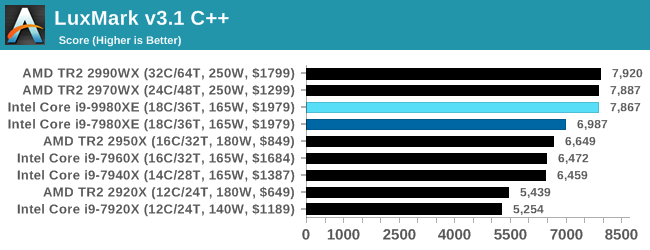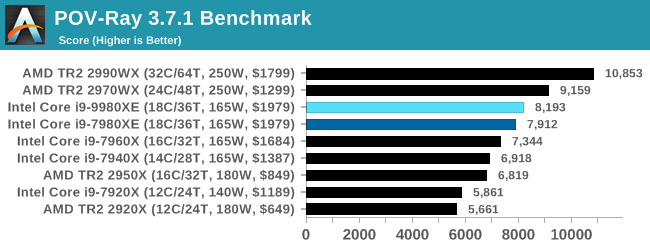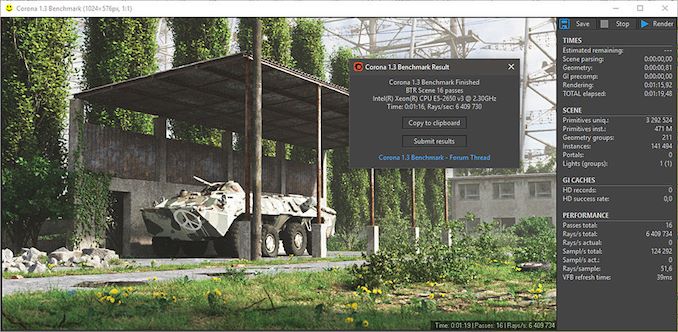The Intel Core i9-9980XE CPU Review: Refresh Until it Hertz
by Ian Cutress on November 13, 2018 9:00 AM ESTHEDT Performance: Rendering Tests
Rendering is often a key target for processor workloads, lending itself to a professional environment. It comes in different formats as well, from 3D rendering through rasterization, such as games, or by ray tracing, and invokes the ability of the software to manage meshes, textures, collisions, aliasing, physics (in animations), and discarding unnecessary work. Most renderers offer CPU code paths, while a few use GPUs and select environments use FPGAs or dedicated ASICs. For big studios however, CPUs are still the hardware of choice.
All of our benchmark results can also be found in our benchmark engine, Bench.
Corona 1.3: Performance Render
An advanced performance based renderer for software such as 3ds Max and Cinema 4D, the Corona benchmark renders a generated scene as a standard under its 1.3 software version. Normally the GUI implementation of the benchmark shows the scene being built, and allows the user to upload the result as a ‘time to complete’.
We got in contact with the developer who gave us a command line version of the benchmark that does a direct output of results. Rather than reporting time, we report the average number of rays per second across six runs, as the performance scaling of a result per unit time is typically visually easier to understand.
The Corona benchmark website can be found at https://corona-renderer.com/benchmark

Corona sees improvement in line with the frequency gain, however the higher core count AMD parts win out here.
Blender 2.79b: 3D Creation Suite
A high profile rendering tool, Blender is open-source allowing for massive amounts of configurability, and is used by a number of high-profile animation studios worldwide. The organization recently released a Blender benchmark package, a couple of weeks after we had narrowed our Blender test for our new suite, however their test can take over an hour. For our results, we run one of the sub-tests in that suite through the command line - a standard ‘bmw27’ scene in CPU only mode, and measure the time to complete the render.
Blender can be downloaded at https://www.blender.org/download/

Similarly with Blender as to Corona: the new Intel Core i9-9980XE performs better than the previous generation 7980XE, but sits behind the higher core count AMD parts.
LuxMark v3.1: LuxRender via Different Code Paths
As stated at the top, there are many different ways to process rendering data: CPU, GPU, Accelerator, and others. On top of that, there are many frameworks and APIs in which to program, depending on how the software will be used. LuxMark, a benchmark developed using the LuxRender engine, offers several different scenes and APIs. *It has been mentioned that LuxMark, since the Spectre/Meltdown patches, is not a great representation of the LuxRender engine. We still use the test as a good example of different code path projections.
In our test, we run the simple ‘Ball’ scene on both the C++ and OpenCL code paths, but in CPU mode. This scene starts with a rough render and slowly improves the quality over two minutes, giving a final result in what is essentially an average ‘kilorays per second’.

Our test here seems to put processors into buckets of performance. In this case, the Core i9-9980XE goes up a bucket.
POV-Ray 3.7.1: Ray Tracing
The Persistence of Vision ray tracing engine is another well-known benchmarking tool, which was in a state of relative hibernation until AMD released its Zen processors, to which suddenly both Intel and AMD were submitting code to the main branch of the open source project. For our test, we use the built-in benchmark for all-cores, called from the command line.
POV-Ray can be downloaded from http://www.povray.org/

POV-Ray is as expected: a performance improvement, but behind the higher core count AMD parts.












143 Comments
View All Comments
at8750 - Tuesday, November 13, 2018 - link
Hi, Ian.Did Intel officially announce Skylake-X Refresh be manufactured on 14++ node?
But 9980XE Stepping is the same as 7980XE.
Stepping is 4, there is no change.
SanX - Tuesday, November 13, 2018 - link
Sometimes the advantage of these processors with AVX512 versus usual desktop processors with AVX2 is crazy. The 3D particle tests fly like 500 mph cars. Which other tasks besides 3D particle movement also benefit from AVX512?How about linear algebra? Does Intel MKL which seems now support these extensions demonstrate similar speedups with AVX512 on solutions Ax=B, say, with the usual dense matrices?
TitovVN1974 - Friday, November 16, 2018 - link
Pray look up linpack results.SonicAndSmoke - Tuesday, November 13, 2018 - link
@Ian: What's with that paragraph about the Mesh clocks on page 1? Mesh clock is 2.4 GHz stock on SKX, and there is no mesh turbo at all. You can check for yourself with AIDA64 or HwInfo. So does SKX-R have the same 2.4 GHz clock, or higher?Tamerlin - Tuesday, November 13, 2018 - link
Thorough review as always.I'd like to request that you consider adding some DaVinci Resolve tests to your suite, as it would be helpful for professional film post production professionals. There is a free license which has enough capability for professional work, and there is free raw footage available from Black Magic's web site and 8K raw footage available from Red's.
Thanks :)
askmedov - Tuesday, November 13, 2018 - link
Intel is playing with fire by doing incremental upgrades over and over again. Look no further than Apple's new iPads - their chips are better than what Intel has to offer in terms of price-power-efficiency. Apple is going to ditch Intel's processors very soon for most of its Mac lineup.bji - Tuesday, November 13, 2018 - link
Microsoft Windows is known to suck hard when it comes to performance on NUMA architectures and particularly the TR2 processors. See Phoronix for analysis.Why does Anandtech continue to post Windows-only benchmarks? They are fairly useless; they tell more about the limitations of Microsoft Windows than they do the processors themselves.
Of course, if you're a poor sap stuck running Windows for any task that requires these processors, I guess you care, but you really should be pushing your operating system vendor to use some of their billions of dollars to hire OS developers who know what they are doing.
I just bought a TR2 1950X for my software development workstation (Linux based) and I am fairly confident that for my work loads, it will kick the crap out of these Intel processors. I wouldn't know for sure though because I tend to read Anandtech fairly exclusively for hardware reports, dipping into sites like Phoronix only when necessary to get accurate details for edge cases like the TR2.
It sure would be nice if my site of choice (Anandtech) would start posting relevant results from operating systems designed to take advantage of these high power processors instead of more Windows garbage ... especially Windows gaming benchmarks, as if those are even remotely relevant to this CPU segment!
bji - Tuesday, November 13, 2018 - link
Erp I meant 2950X, sorry typo there.Shaky156 - Wednesday, November 14, 2018 - link
I have to agree 110%, gaming benchmarks are more gpu/ipc related more than a multicore cpu benchmark.Somehow seems anandtech could be biased
eva02langley - Wednesday, November 14, 2018 - link
Totally agree, we have come to a time that benchmarks are not even accurately evaluating the product anymore. The big question is how can we depict an accurate picture? Especially if the reviewer is not choosing the right ones properly for real comparison.Well, seeing disparity from Phoronix is raising major concern to me.